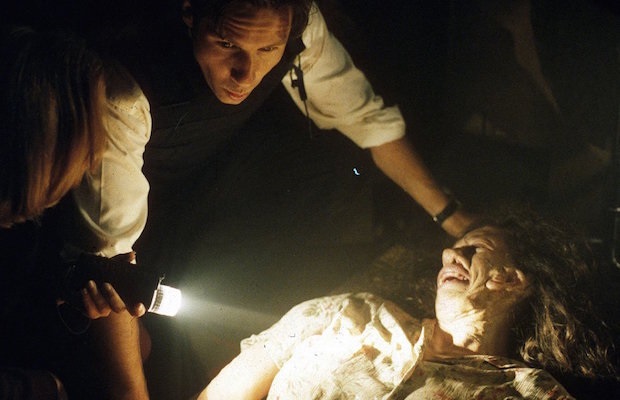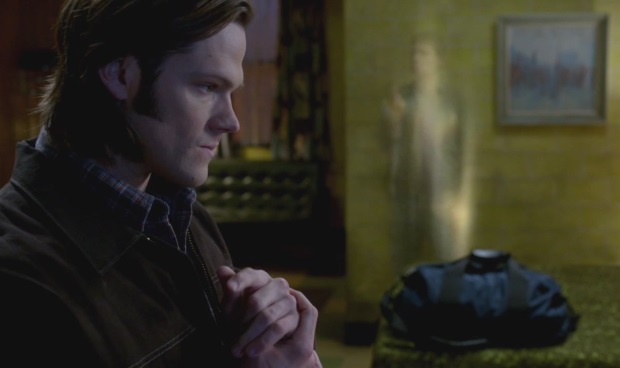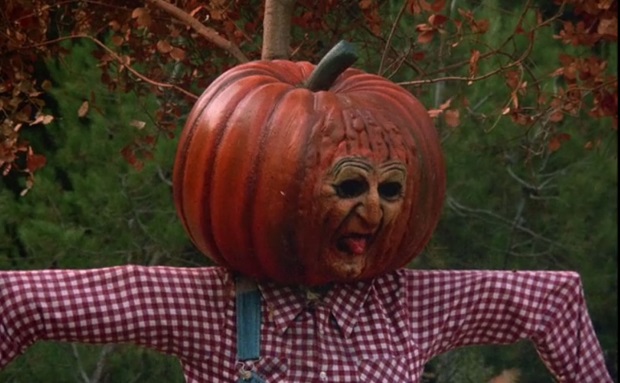Which is Scarier – Human Evil or Supernatural Evil?
Is otherworldly evil more chilling than its earthly counterpart? Juliette evaluates TV horror's treatment of both...
This article comes from Den of Geek UK.
This article contains spoilers for The X-Files, Supernatural, Quantum Leap and Inside No. 9.
Scary stories come in all sorts of different forms. Some are about the spooky and the weird – ghosts, witches, vampires, werewolves and other supernatural nasties. Some explore the horrors of technology and where that might lead us. Other stories exist in the here and now, in the mundane world, and tell of human horrors – of how cruel people can be to other people and how dangerous other people sometimes are.
For the most part, these different types of scary story tend to exist in separate spheres, and we often know in advance what type we’re watching, But sometimes, the fantastical type and the mundane type may be mixed up together. When we tell scary stories at Halloween, we might tell urban legends about hook-handed escaped killers or home invasions alongside stories about ghosts and ghouls. A handful of TV shows have also embraced both supernatural and more mundane, human threats over the course of their runs – currently running examples include Supernatural, The X-Files, Inside No. 9, and American Horror Story.
The point of a Halloween story or a horror show is to scare ourselves. But which type of story is scarier? Is it the supernatural variety – the menace lurking in the shadows, the primal fear of what might be under the bed, the idea that a creaky door or noisy pipe might not be as innocent as it seems? But most of us don’t believe vampires or witches or werewolves are real. So are the more mundane stories the more terrifying, because there’s a chance, however small, that the same thing could happen to us?
If we return to our recent TV examples (excluding American Horror Story, which tells a smaller number of more extended arc stories and is less episodic), it might perhaps be worth considering which are the scariest episodes these shows have produced, and what sort of threat they feature. It doesn’t take much poking around on the internet to discover that one of the episodes considered by many to be the scariest ever of The X-Files is Home. This is an entirely non-paranormal episode in which the villains turn out to be an extremely in-bred family living in rural America, who keep their limbless mother (with whom they have all had sexual relations and numerous deformed children) under the bed in the family home. It was the first episode of the horror show to get a viewer discretion warning on its initial broadcast and was not repeated for a while afterwards.

What makes Home so memorably scary? Part of the appeal (or lack thereof) is that it’s rather gruesome. But the whole idea behind the episode is horrifying in itself. Your skin crawls while you watch it, not because you necessarily think the Peacocks might be living next door (unless you live in an isolated part of rural America) but because you imagine that they might live somewhere. This is not the fear of encountering the horror yourself, any more than most viewers fear meeting a witch or werewolf. In fact, it is the fear of not meeting it – of this horror existing in the world unknown and un-captured – that really gets to you. The Peacocks might be (hopefully) a very long way away, but they could exist, and however grim their lifestyle is, it is plausible.
Other scary X-Files episodes frequently appearing on ‘scariest episode’ or ‘scariest monster’ lists include Irresistible, The Host, Die Hand Die Verlezt, Tooms/Squeeze, and Folie A Deux. Most are paranormal, but Irresistible is another rare episode featuring a purely human (if grotesque) serial killer and necrophiliac (other episodes of this nature include The Jersey Devil and the appropriately named Grotesque). In both Home and Irresistible, it is the mundane nature of the killers combined with the particularly icky nature of their crimes that produces the horror – they are non-paranormal, but not exactly ‘normal’ either.
A brief and highly unscientific glance over the episodes of Supernatural that crop up repeatedly in ‘scariest episode’ lists turns up a few recurring favorites, including the Pilot, Bloody Mary, Asylum, Everybody Loves A Clown, No Exit, The Kids Are Alright, Family Remains, and Repo Man. Family Remains was the second Supernatural episode to feature purely human villains (following The Benders) and is clearly inspired by The X-Files’ Home, while Repo Man features a human serial killer trying to reunite with a demon that once possessed him, and No Exit’s villain manages the double whammy of being the ghost of a serial killer. In Supernatural, as in its spiritual parent The X-Files, the most terrifyingly memorable villains are often the more human ones.

Inside No. 9 is a much newer show and plays on a British format, with far fewer episodes, and so less online space has been devoted to discussions of its scariest episodes. However, we’d hazard a guess that the episodes most likely to send a chill up your spine are probably The Harrowing, Séance Time, The Riddle Of The Sphinx, Private View and To Have And To Hold (and a quick Google for ‘scary Inside No. 9’ brings up reviews of The Harrowing, To Have And To Hold and Séance Time on the first two pages). That’s one definitely supernatural episode, one possibly supernatural episode and three about human evil-doers. Inside No. 9’s 24 episodes include three with definitely supernatural elements (The Trial Of Elizabeth Gadge, Séance Time and Tempting Fate), one with probable supernatural elements (The Harrowing – but they could just be really weird and unpleasant people, not unlike Home), and three that play with visions and perceptions without necessarily implying supernatural activity (Tom And Gerri, The Twelve Days Of Christine and Bernie Clifton’s Dressing Room) while the remaining 17 are more mundane, if violent (13 of them featuring at least one murder or attempted murder).
Whereas the episodes that scared viewers the most in the supernatural shows were often the rare mundane ones, the scariest episodes of Inside No. 9 are often the rare overtly supernatural ones. Partly this is because the very fact of something being unexpected can be scary. Quantum Leap set itself up as a series of short dramas driven by a science fiction premise but largely focused on more mundane activity. But the show never forgot it was speculative fiction and threw several horror-themed episodes into its five-year run. In addition to the occasional serial killer, the show featured a vampire, a mummy, a ghost, and the Devil himself, in a Halloween episode frequently praised by fans for being genuinely creepy.

Most supernatural horrors are easily relegated to the world of fiction, but if you want to blend the spook factor of the fantastical with the it-could-happen-to-me horror of the mundane, your best bet is a ghost story. For many people, ghosts are no more real than witches or vampires, but even the most hardened sceptic may get the occasional shiver in a darkened room, though they may quickly rationalise it away. And a 2014 YouGov poll suggested that up to one third of people living in the UK believe in ghosts, giving the prospect of meeting an unfriendly one all the creep factor of a fantastical story, combined with all the gnawing horror of a mundane one.
In the end, neither supernatural stories nor more mundane ones are automatically scarier than each other. Sure, non-believers can rationalise away the existence of ghosts, ghouls and witches, but most of us don’t go about our day to day life convinced we’re about to be offed by serial killers either (if we do, that’s another issue all together). The non-paranormal stories that have terrified viewers deal with subjects just as weird and taboo as the paranormal – Home, Family Remains and The Riddle Of The Sphinx all deal with incest, for example. What really terrifies is the unexpected, the twist the audience genuinely didn’t see coming, the sting in the tail. Whether it’s a ghost, a ghoul or a human monster, that is what will really scare your audience silly.
